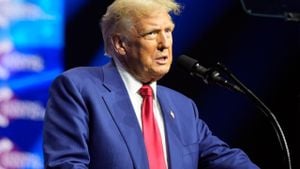It's official: the political climate across America has reached fever pitch as the nation gears up for the highly anticipated 2024 Presidential Election, pitting Donald Trump against Kamala Harris. The stakes couldn’t be higher, with polls showing fluctuated support for both candidates leading to intense political maneuvering and strategic campaigning. On one hand, Trump’s supporters are optimistic, inspired by recent election results and another fervor of MAGA enthusiasm. On the other, Harris and her team are striving to rally undecided voters, all of whom are eager to determine the future of the country.
Recent reports suggest Trump is projected to retake the presidency, with multiple key states swinging his direction. After the announcement of projected wins for Georgia and North Carolina, jubilant Trump supporters gathered at the West Palm Beach County Convention Center. Trump, basking in the roar of his supporters, declared victory early Wednesday morning, positioning himself for another term. His supporters, fueled by his messages of economic growth and national pride, maintain fervent belief.
“It’s not just about winning; it’s about reclaiming our country,” one supporter exclaimed, standing firm on the notion of re-establishing Trump’s America.
Conversely, Harris is grappling with the reality of her dwindling path to victory. With projections showing her electoral votes falling short, the Vice President is determined to defend her record. The Harris campaign emphasizes unity, diversity, and progress, attempting to counteract Trump’s narrative. During rallies, she promoted her accomplishments, saying, “This election isn’t just about one person; it’s about all of us rising together.”
The voter demographic appears to be playing a significant role as well. Young voters, traditionally leaning Democratic, are increasingly listening to Harris as they face the issues of climate change, education, and social justice. Yet, skepticism remains. A college student noted, “I want to believe she stands for our interests, but I feel the establishment doesn't understand the urgency of our concerns.”
Both campaigns have made creative outreach efforts to solidify their bases. Trump has ramped up appearances at rallies, stressing law and order, and highlighting his achievements during his presidency. It’s no wonder his supporters, passionate and vocal, gathered outside stadiums, chanting slogans as if leading a pop concert.
Meanwhile, Harris is leveraged to counter Trump’s achievements by inviting prominent figures within the Democratic party to highlight her social policies, particularly around health care. “We are building on the progress made and ensuring everyone has access to quality care,” she assured during one event.
But beyond the surface of partisanship lies another aspect: voter sentiments around issues like inflation and the economy, which have become blockbuster issues this election season. Many Americans are worried about rising costs and dwindling savings, which has led to discussions about economic policies. A retired factory worker shared mixed feelings, stating, “I want to support Harris, but I’m cautious; I need to see how these plans will work out for my wallet.
The coming weeks will see intense conversations and concerns among various communities as early voting begins. Voter guides are being distributed widely, and organizations are running campaigns to clarify where each candidate stands on hot-button issues like education and health.
Stepping back from campaigns and debates, the role of media bias is under heavy scrutiny this election season. The Washington Post, CNN, and Fox News have all been accused of leaning biased coverage depending on their political leanings. This adds another layer of complexity to the information voters are receiving, and how it influences their experiences at the polls. A group of local activists expressed discontent with mainstream media coverage, insisting on more balanced reporting to reflect the diversity of perspectives and issues facing voters.
While the outcome of the election remains uncertain, various candidates have begun outlining their views, as seen through the plethora of voter guides surfacing online. These guides aim to inform citizens on candidates’ positions, helping them make educated decisions during the highly consequential election.
Election Day, expected to be chaotic and lively, has already sparked conversations about mail-in voting and the reliability of electoral systems. The Pennsylvania Supreme Court’s ruling favoring Republicans on mail-in ballots raised eyebrows and concerns. Some experts worry this could lead to additional polarization as parties contest the outcomes.
Another prominent theme has emerged: the role of celebrity endorsements. Celebrities such as Alyssa Farah Griffin, previously aligned with Trump, have switched sides, now supporting Harris. On The View, she expressed, "For the first time, I voted for Democrats." This twist adds unexpected dynamics to voter decisions, as their influences can sometimes swing votes. Many followers of these celebrities are eager to see how much power their endorsements hold over their personal networks.
Looking forward, the road to the election leads to uncomfortable conversations about policies, personalities, and preferences. Swayed questions about character, leadership style, and past records will dominate discussions as voters weigh their options by connecting with issues they care about.
With days left until early votes begin to be counted, the candidates are fortifying their strategies to hit the ground hard. Mobilization efforts are at peak levels, with grassroots movements leading the charge for both sides. Each campaign understands the necessity of local engagement to inspire voters to turn out and cast their ballots this November.
The battle for swing states remains fierce, with both candidates making strategic visits across the map. Florida, Ohio, and Pennsylvania are areas where both campaigns are making headway to broaden their outreach, aiming at key demographic groups to pull voters toward their policies. On the ground, volunteers and campaign teams flood places like college campuses and senior centers, tapping every opportunity to discuss policies and rally support.
The result of this political tug-of-war will be revealed soon, but one thing remains clear: the 2024 election has fireworks potential as tensions rise, narratives shift, and the future of the nation hangs delicately, poised on the choices its citizens will make.



